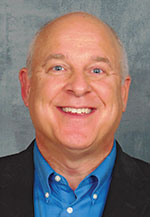Ken’s 12-Pack / Ken Ogorek
Things most Catholics wish they knew better: A package deal includes all four marks of the Church

Fourth in a yearlong catechetical series
“Diversity is awesome!” (When balanced with unity.)
Most of us are familiar with the four marks of the Church: one, holy, catholic and apostolic.
Catechetical textbooks in the 1970s and 1980s tended to overemphasize one or two of our Church’s key traits while offering a deficient presentation of marks like unity (oneness) and a full picture of what it means to be apostolic.
Can you be too Catholic?!
The word catholic (small “c”) has several layers of meaning. In one sense, calling the Church catholic acknowledges her beautiful diversity as the worldwide Body of Christ, a universal family embracing what’s good, true and beautiful in every culture.
But diversity has its limits. Legitimate diversity flourishes under an umbrella of core truths, taught with loving authority by those whom Jesus identifies as leaders in teaching ministry. Diversity for its own sake leads to chaos; when the Church’s one-ness (unity) complements her catholicity, we enjoy the fruits of authentic diversity by God’s grace and mercy.
Jesus established a Church
Our Lord Jesus clearly intended to form a group of people who would carry out his mission and ministry until he returns in glory.
Church teaching doesn’t exist in a vacuum; the life of our Church—including a basic organizational structure willed by Jesus—blesses us with a context for learning and sharing each basic doctrinal and moral teaching.
Like the word catholic, the word apostolic describes our Church on several levels of meaning.
When the role of the Apostles and their successors, our bishops, is understated, we become especially vulnerable to inaccurate teaching that can mislead us about who God is and how we should live.
Jesus established the Church to continue both his presence and his mission in the world. The Church has a teaching function. Bishops and priests are blessed by Jesus with a leadership role in sharing the treasures of sacred Scripture and sacred tradition.
While it’s true—and important!—that all baptized persons are called to teach the faith in various ways, this general call unfolds in the context of a basic, hierarchical structure willed by Christ.
But it’s a tradition!
It’s been said that tradition is different than traditionalism. Tradition is the living faith of the dead, while traditionalism is the dead faith of the living.
If you were a young Catholic from the late 1960s through the early 1990s, what you were taught about the Church might have been lacking in how the Church’s marks of one and apostolic were explained. Rather than miring us in a stale traditionalism, the apostolic trait of our Church helps make accessible for every generation the saving truths of sacred tradition.
Thankfully we have the Catechism of the Catholic Church to remind us that “Sacred Tradition and Sacred Scripture make up a single sacred deposit of the Word of God in which, as in a mirror, the pilgrim Church contemplates God, the source of all her riches” (#97).
When all four marks of the Church— one, holy, catholic and apostolic—are taught clearly, the clear connection between the Church, her teaching and her glorious founder Jesus establishes a helpful context for learning and living his teaching.
(Ken Ogorek, archdiocesan director of catechesis, has lost his six-pack
abs. But his 12-part series, whose theme is: Things Most Catholics
Wish They Knew Better, will run through December. He can be
reached at his archdiocesan e-mail address kogorek@archindy.org or
by using the contact information at
www.kenogorek.com.) †
